Exam Details
Exam Code
:350-401Exam Name
:Implementing and Operating Cisco Enterprise Network Core Technologies (ENCOR)Certification
:CCNP EnterpriseVendor
:CiscoTotal Questions
:1407 Q&AsLast Updated
:Mar 28, 2025
Cisco CCNP Enterprise 350-401 Questions & Answers
-
Question 71:
Which of the following are the three components of the three-tier hierarchical networking model used in the classical Cisco networks design? (Choose three.)
A. Distribution
B. Core
C. Access
D. Leaf
E. Spine
-
Question 72:
In a Cisco SD-WAN network, which VPN Identifier is reserved as the transport VPN, carrying control traffic?
A. VPN 0
B. VPN 1
C. VPN 512
D. VPN 514
-
Question 73:
In a Cisco SD-WAN network, which VPN Identifier is reserved for carrying out-of-band network management traffic?
A. VPN 0
B. VPN 1
C. VPN 512
D. VPN 514
-
Question 74:
SIMULATION
Guidelines
This is a lab item in which tasks will be performed on virtual devices.
1.
Refer to the Tasks tab to view the tasks for this lab item.
2.
Refer to the Topology tab to access the device console(s) and perform the tasks.
3.
Console access is available for all required devices by clicking the device icon or using the tab(s) above the console window.
4.
All necessary preconfigurations have been applied.
5.
Do not change the enable password or hostname for any device.
6.
Save your configurations to NVRAM before moving to the next item.
7.
Click Next at the bottom of the screen to submit this lab and move to the next question.
8.
When Next is clicked, the lab closes and cannot be reopened.
Topology
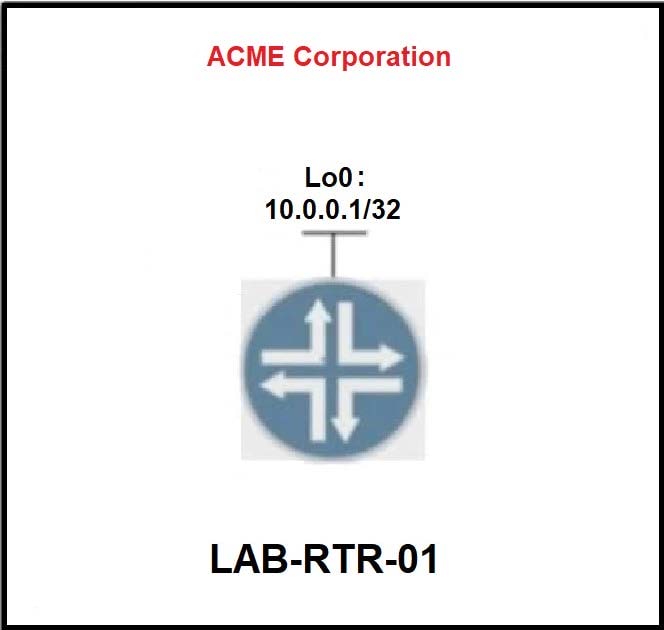
Tasks
Configure an EEM applet on LAB-RTR-01 that will automatically re-enable interface Loopback0 if it is administratively shut down.
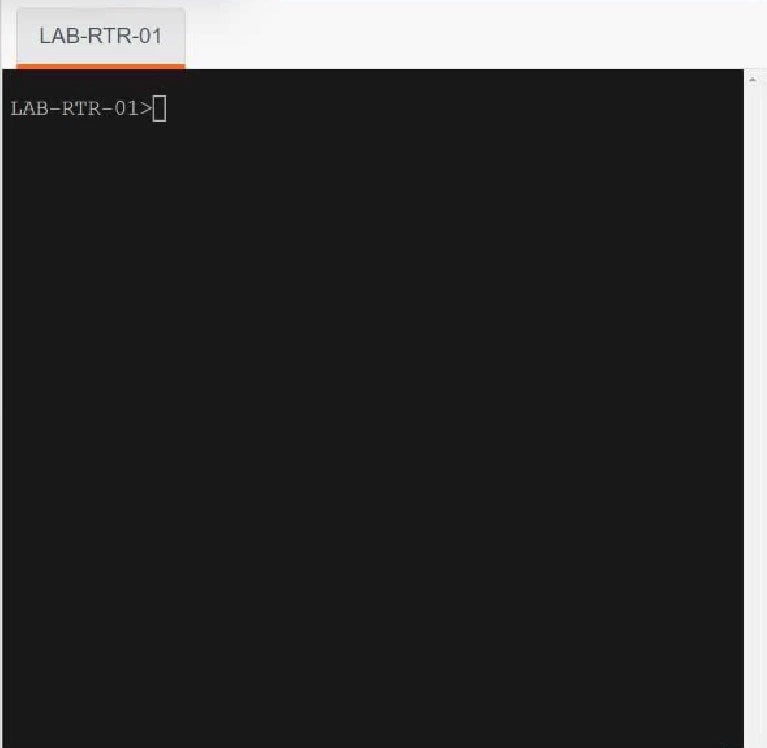
A. See the solution below in Explanation.
B. Place Holder
C. Place Holder
D. Place Holder
-
Question 75:
SIMULATION
Guidelines
This is a lab item in which tasks will be performed on virtual devices.
1.
Refer to the Tasks tab to view the tasks for this lab item.
2.
Refer to the Topology tab to access the device console(s) and perform the tasks.
3.
Console access is available for all required devices by clicking the device icon or using the tab(s) above the console window.
4.
All necessary preconfigurations have been applied.
5.
Do not change the enable password or hostname for any device.
6.
Save your configurations to NVRAM before moving to the next item.
7.
Click Next at the bottom of the screen to submit this lab and move to the next question.
8.
When Next is clicked, the lab closes and cannot be reopened.
Topology

Tasks
Configure logging on SW01 and NetFlow on R01 to achieve these goals:
1.
Enable archive logging on SW01 to track each time a change is made to the configuration and the user who made the change.
2.
The NetFlow Top Talkers feature has been preconfigured on R01. Enable the feature for all inbound traffic on interface E0/2 of R01.
R01
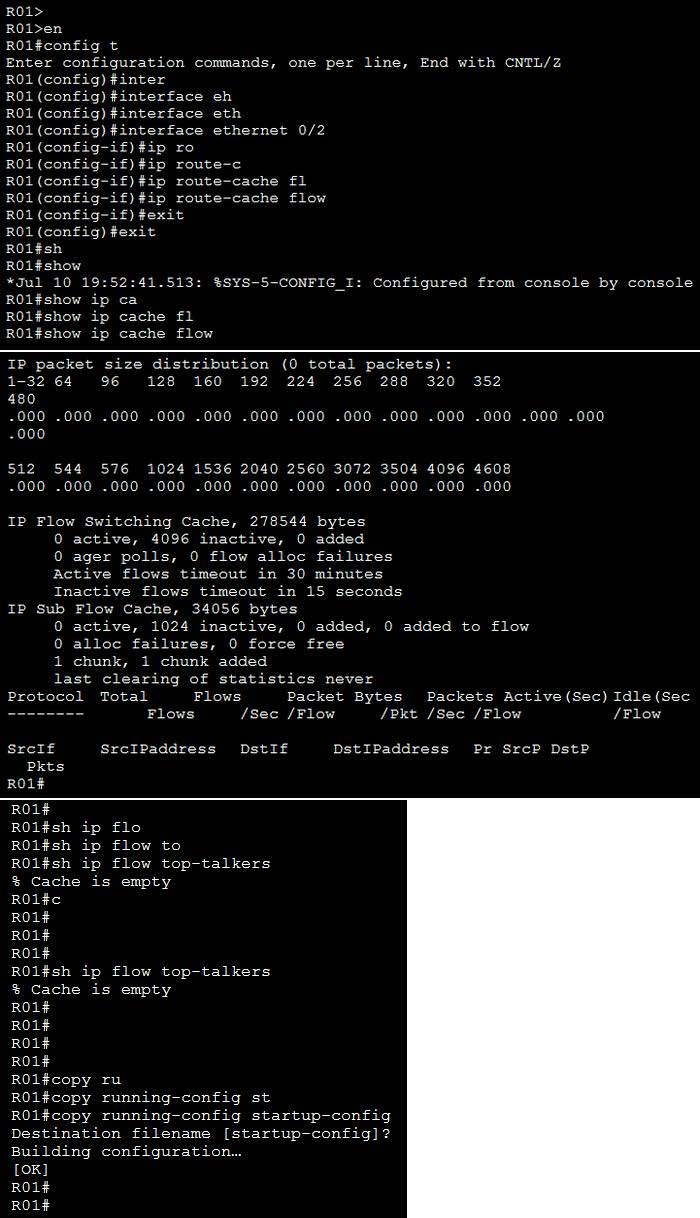
SW01
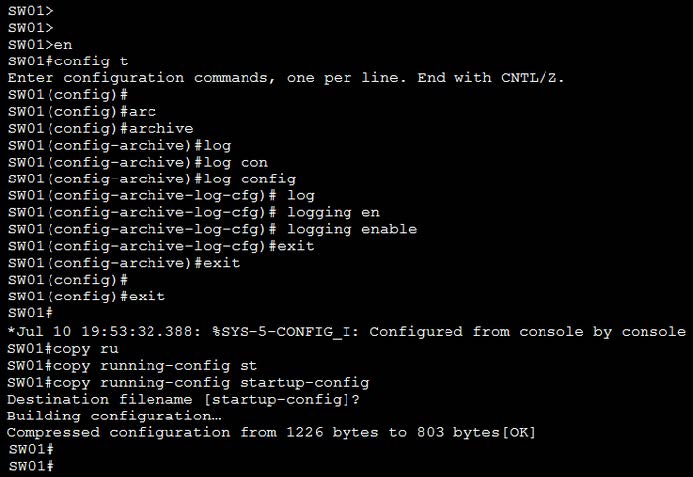
A. See the solution below in Explanation.
B. Place Holder
C. Place Holder
D. Place Holder
-
Question 76:
SIMULATION
Guidelines
This is a lab item in which tasks will be performed on virtual devices.
1.
Refer to the Tasks tab to view the tasks for this lab item.
2.
Refer to the Topology tab to access the device console(s) and perform the tasks.
3.
Console access is available for all required devices by clicking the device icon or using the tab(s) above the console window.
4.
All necessary preconfigurations have been applied.
5.
Do not change the enable password or hostname for any device.
6.
Save your configurations to NVRAM before moving to the next item.
7.
Click Next at the bottom of the screen to submit this lab and move to the next question.
8.
When Next is clicked, the lab closes and cannot be reopened. Topology

Tasks
Configure the devices according to the topology to achieve these goals:
1.
Configure a SPAN session on SW01 using these parameters: Session Number: 20 Source Interface: VLAN 99 Traffic Direction: Transmitted Traffic Destination Interface: Ethernet0/1
2.
Configure the NetFlow Top Talkers feature for outbound traffic on interface E0/2 of R01 with these parameters: Number of Top Talkers: 50 Sort Type: Packets Cache Timeout: 30 seconds
3.
Configure an IP SLA operation on SW02 and start the ICMP probe with these parameters: Entry Number: 10 Target IP: 1.1.1.1 Source IP: 172.16.2.2 Frequency: 5 seconds Threshold: 250 milliseconds Timeout: 3000 milliseconds Lifetime: Forever
A. See the solution below in Explanation.
B. Place Holder
C. Place Holder
D. Place Holder
-
Question 77:
SIMULATION
Guidelines
This is a lab item in which tasks will be performed on virtual devices.
1.
Refer to the Tasks tab to view the tasks for this lab item.
2.
Refer to the Topology tab to access the device console(s) and perform the tasks.
3.
Console access is available for all required devices by clicking the device icon or using the tab(s) above the console window.
4.
All necessary pre-configurations have been applied.
5.
Do not remove any existing configurations from the devices, only those necessary to make the appropriate changes required to fulfill the listed tasks.
6.
Do not change the enable password or hostname for any device.
7.
Save your configurations to NVRAM before moving to the next item.
8.
Click Next at the bottom of the screen to submit this lab and move to the next question.
9.
When Next is clicked, the lab closes and cannot be reopened.
Topology
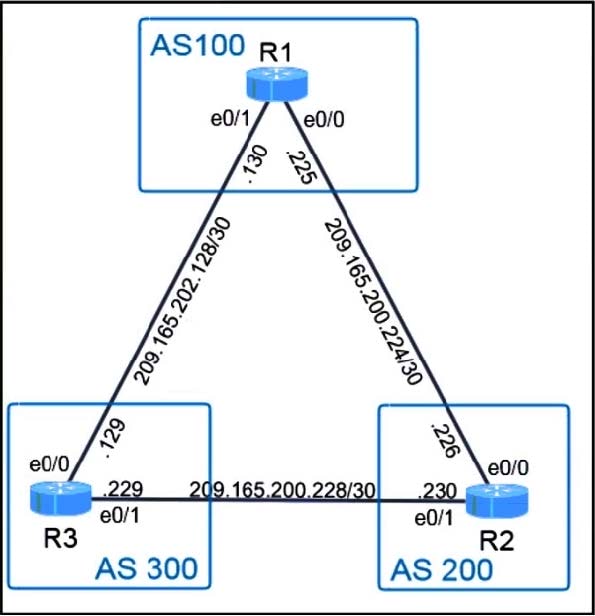
1
Configure R1 according to the topology to achieve these results:
Tasks
1.
Configure eBGP using Loopback 0 for the router-id. Do not use the address-family command to accomplish this.
2.
Advertise R1's Loopback 100 and Loopback 200 networks to AS200 and AS300.

A. See the solution below in Explanation.
B. Place Holder
C. Place Holder
D. Place Holder
-
Question 78:
SIMULATION
Guidelines
This is a lab item in which tasks will be performed on virtual devices.
1.
Refer to the Tasks tab to view the tasks for this lab item.
2.
Refer to the Topology tab to access the device console(s) and perform the tasks.
3.
Console access is available for all required devices by clicking the device icon or using the tab(s) above the console window.
4.
All necessary preconfigurations have been applied.
5.
Do not change the enable password or hostname for any device.
6.
Save your configurations to NVRAM before moving to the next item.
7.
Click Next at the bottom of the screen to submit this lab and move to the next question.
8.
When Next is clicked, the lab closes and cannot be reopened.
Topology
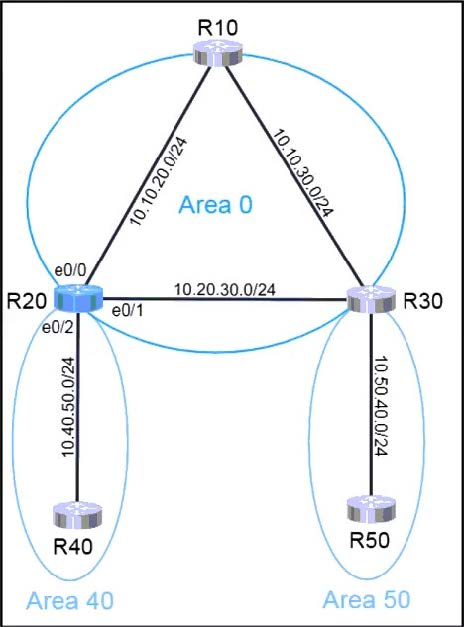
Tasks
OSPF is preconfigured on all devices except R20. Configure R20 to complete these tasks.
Task 1:
Configure OSPF according to the topology using these requirements:
1.
Use Process ID 10.
2.
Use Loopback1 for the Router ID.
3.
Advertise all networks into OSPF.
- Use network statements under the OSPF process to accomplish this task. Task 2: Configure a /20 summary route for Area 40. Advertise only Type 3 LSAs into Area 0. R20

A. See the solution below in Explanation.
B. Place Holder
C. Place Holder
D. Place Holder
-
Question 79:
SIMULATION
Guidelines
This is a lab item in which tasks will be performed on virtual devices.
1.
Refer to the Tasks tab to view the tasks for this lab item.
2.
Refer to the Topology tab to access the device console(s) and perform the tasks.
3.
Console access is available for all required devices by clicking the device icon or using the tab(s) above the console window.
4.
All necessary preconfigurations have been applied.
5.
Do not change the enable password or hostname for any device.
6.
Save your configurations to NVRAM before moving to the next item.
7.
Click Next at the bottom of the screen to submit this lab and move to the next question.
8.
When Next is clicked, the lab closes and cannot be reopened.
Topology
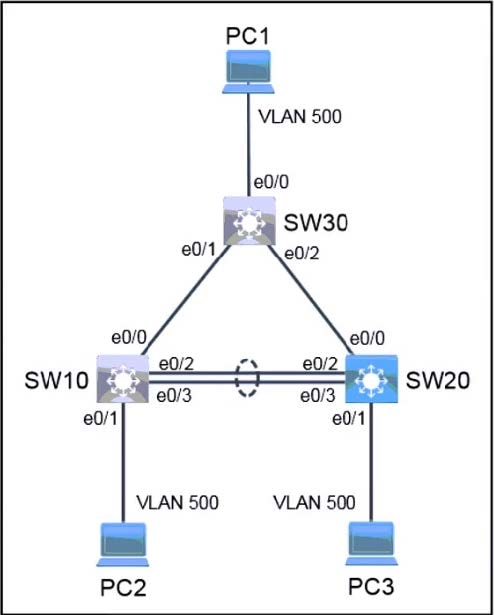
Tasks
The operations team started configuring network devices for a new site. Complete the configurations to achieve these goals:
1.
Configure Rapid PVST+ on SW20.
2.
The trunk between SW20 and SW30 is not operational. Troubleshoot the issue and ensure PC3 can ping PC1 (10.10.100.10) across the link.
3.
The LACP port channel between SW10 and SW20 is not operational. Troubleshoot the issue and ensure PC3 can ping PC2 (10.10.100.20) across the port channel. Note: No access is provided to SW10 or SW30. Resolve these issues by making changes only to SW20. Traffic on all trunks should be restricted to only active VLANs.

A. See the solution below in Explanation.
B. Place Holder
C. Place Holder
D. Place Holder
-
Question 80:
SIMULATION
Guidelines
This is a lab item in which tasks will be performed on virtual devices.
1.
Refer to the Tasks tab to view the tasks for this lab item.
2.
Refer to the Topology tab to access the device console(s) and perform the tasks.
3.
Console access is available for all required devices by clicking the device icon or using the tab(s) above the console window.
4.
All necessary preconfigurations have been applied.
5.
Do not change the enable password or hostname for any device.
6.
Save your configurations to NVRAM before moving to the next item.
7.
Click Next at the bottom of the screen to submit this lab and move to the next question.
8.
When Next is clicked, the lab closes and cannot be reopened.
Topology Tasks

OSPF is preconfigured on all devices except R20. Configure R20 to complete these tasks.
Task 1:
Configure OSPF according to the topology using these requirements:
1.
Use Process ID 20.
2.
Use Loopback0 for the Router ID.
3.
Advertise all networks into OSPF.
- Do not use network statements under the OSPF process to accomplish this task.
Task 2:
Configure a /18 summary route for Area 40. Advertise only Type 3 LSAs into Area 0.
R20

A. See the solution below in Explanation.
B. Place Holder
C. Place Holder
D. Place Holder
Related Exams:
300-410
Implementing Cisco Enterprise Advanced Routing and Services (ENARSI)300-415
Implementing Cisco SD-WAN Solutions (ENSDWI)300-420
Designing Cisco Enterprise Networks (ENSLD)300-425
Designing Cisco Enterprise Wireless Networks (ENWLSD)300-430
Implementing Cisco Enterprise Wireless Networks (ENWLSI)300-435
Automating and Programming Cisco Enterprise Solutions (ENAUTO)300-440
Designing and Implementing Cloud Connectivity (ENCC)350-401
Implementing and Operating Cisco Enterprise Network Core Technologies (ENCOR)
Tips on How to Prepare for the Exams
Nowadays, the certification exams become more and more important and required by more and more enterprises when applying for a job. But how to prepare for the exam effectively? How to prepare for the exam in a short time with less efforts? How to get a ideal result and how to find the most reliable resources? Here on Vcedump.com, you will find all the answers. Vcedump.com provide not only Cisco exam questions, answers and explanations but also complete assistance on your exam preparation and certification application. If you are confused on your 350-401 exam preparations and Cisco certification application, do not hesitate to visit our Vcedump.com to find your solutions here.